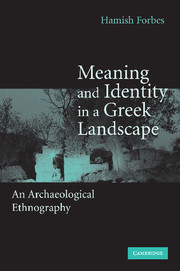Book contents
- Frontmatter
- Contents
- List of Illustrations and Tables
- Preface and Acknowledgements
- Transliteration Conventions
- 1 Introduction
- 2 Landscape Studies: From Frame-and-Tame to Visceral Feeling
- 3 Historical Background to the Landscape of Methana
- 4 Conducting Fieldwork on Methana
- 5 Kinship, Marriage and the Transmission of Names and Property
- 6 The Productive Landscape
- 7 The Historical Landscape: Memory, Monumentality and Time-Depth
- 8 The Kinship Landscape
- 9 The Religious Landscape
- 10 Conclusions: A Greek Landscape from Within
- Glossary
- Notes
- References
- Index
10 - Conclusions: A Greek Landscape from Within
Published online by Cambridge University Press: 04 May 2010
- Frontmatter
- Contents
- List of Illustrations and Tables
- Preface and Acknowledgements
- Transliteration Conventions
- 1 Introduction
- 2 Landscape Studies: From Frame-and-Tame to Visceral Feeling
- 3 Historical Background to the Landscape of Methana
- 4 Conducting Fieldwork on Methana
- 5 Kinship, Marriage and the Transmission of Names and Property
- 6 The Productive Landscape
- 7 The Historical Landscape: Memory, Monumentality and Time-Depth
- 8 The Kinship Landscape
- 9 The Religious Landscape
- 10 Conclusions: A Greek Landscape from Within
- Glossary
- Notes
- References
- Index
Summary
Every person has the obligation to be interested in the place in which he was born and in which he lives…. To know its topography, its history, its progress and everything which relates to it and has any kind of connection with it.
(Athanasiou 1998, 9, quoting a Methana schoolteacher)As an ethnography for archaeologists, this book has presented a case study of a small Greek peninsula. Unlike most ethnographies, the primary focus has not been one or more social or cultural institutions but a tangible material element in Methanites' lives – the landscape. Yet landscapes cannot exist separately from the humans who engage with them: almost all landscapes have been modified in some way or other by humans. The landscapes of settlement and agriculture in particular are spaces which have been materially structured by human activities. More important, landscapes do not have meaning in and of themselves: it is humans who give them their meanings, which are culturally constructed through the medium of senses and knowledge informed by a person's culture – as encompassed by the opening quotation to this chapter, with which Athanasiou's (1998) book on Methana begins. Without those meanings given to them by human groups, they are merely environments. For this reason, an initial ethnographic focus on the material landscape of Methana led inevitably into areas of Methanites' culture, such as production, reproduction, and the structuring of people's links with other humans and with the supernatural.
- Type
- Chapter
- Information
- Meaning and Identity in a Greek LandscapeAn Archaeological Ethnography, pp. 395 - 408Publisher: Cambridge University PressPrint publication year: 2007



